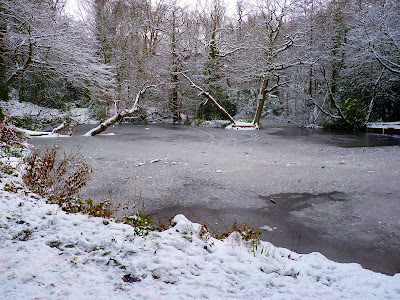And so for the arachnophobes, (Ladies!) I thought I'd try and make-up for any distress caused by providing another update that will not only be spider-free, but will consist of just 'pretty-pretty' photographs...
Click on any photo for larger view
Yesterday morning I was out and about quite early and it was just a joy to be walking in the fog and mist with the sun just breaking through...
At one point the sun burst through a line of distant trees and I tried to get the camera as low to the ground as possible to include the frosty landscape...
Sometimes I just get inspired to take photographs by the conditions and beauty of nature itself. This particular morning was one of those times when not only did things seem to be demanding to be photographed, but for once, everything that I attempted seemed to result in a photograph that was very close to what I pictured in my mind when taking the shot....that doesn't happen often and so I made the most of it...
I know the purists amongst my photographer friends will say that in these pictures the light around the sun is 'blown' but I actually don't mind that myself and it is very close to how I experienced it.
The stands of what I think were cow parsley? made for quite a dramatic addition to the landscape...
I suppose I must have been out walking for about an hour when I took these next pictures and by now the sun was beginning to burn off the mist...
I need to revisit this particular area at dawn one day, or perhaps dusk, because I think I might get an opportunity to photograph roe deer. Just to the left of these pictures I spotted signs of the deer...
Now although I really enjoyed using the point & shoot for these landscape shots, in fact I have been inspired to try more of this kind of thing by one particular flickr contact (you know who you are) I found the lure of the macro lens to hard to resist entirely. The following two photos are from the DSRL with the 100mm macro attached...
 |
| Ice on a leaf edge |
 |
| Ice in a puddle |
That then was my early morning walk on a day that developed into a real beauty with cloudless blue skies. A far cry from the next photo taken around a week ago...
Before I take my leave until the next update, returning to the spiders for just a moment...have you heard of 'exposure therapy'? Well my excuse for including them occasionally is based around this (honestly)... systematic desensitisation! It's for your own good...the more pictures you see, the less you become afraid.
A few other arachnophobia facts:
Percentage of women affected compared to men? What would you think?
Answer: Women: 50% Men: 10%
Some scientists believe that we may be born with the phobia.
Would you say that arachnophobia is a common phobia that affects many people?
Answer: Latest estimates put it at only a maximum of 6% of the population.
Until the next time then...

















































